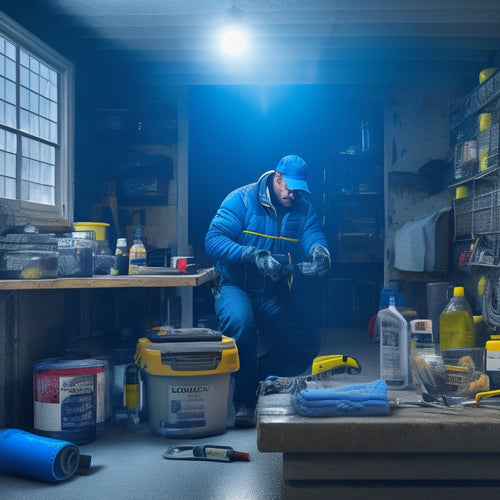
What's Driving Innovation in Lithium Ion Batteries?
Share
You're likely wondering what's driving innovation in lithium-ion batteries. Well, it's advances in solid-state electrolytes, advanced material compositions, and innovative architectures that are drastically enhancing performance, safety, and charging speeds. Breakthroughs in high-energy density cells, fast charging capabilities, and enhanced thermal management are also playing a significant role. Additionally, 3D-printed battery architectures, advanced battery management systems, and innovative electrode materials like lithium-rich cobalt-based cathodes and graphene-based electrodes are pushing the boundaries of what's possible. As you explore further, you'll uncover even more cutting-edge technologies shaping the future of lithium-ion batteries.
Key Takeaways
• Solid-state electrolytes enhance battery performance by facilitating ionic conduction and reducing interfacial resistance.
• Advanced material compositions, such as nanostructured materials, optimize properties for improved energy density and thermal stability.
• Novel electrode architectures and 3D-printed battery designs enable intricate structures that increase energy density and power density.
• Fast charging capabilities are driven by new materials with improved ionic conductivity, optimized cell design, and advanced power electronics.
• Advanced thermal management systems, including heat pipes and phase-change materials, prevent overheating and ensure efficient battery operation.
Solid-State Electrolyte Breakthroughs
Researchers have made significant strides in solid-state electrolyte breakthroughs, paving the way for safer, more efficient lithium-ion batteries with enhanced energy density and reduced charging times.
You may wonder what makes solid-state electrolytes so promising. The key lies in their ability to facilitate ionic conduction, which enables the efficient flow of ions between the electrodes. This results in improved battery performance, as the electrolyte's ionic conductivity plays an essential role in determining the battery's overall efficiency.
However, the interfacial resistance between the solid electrolyte and electrodes remains a significant challenge. When the electrolyte and electrodes come into contact, resistive layers can form, hindering ionic conduction and reducing battery performance. By understanding and mitigating this interfacial resistance, you can harness the full potential of solid-state electrolytes, paving the way for the next generation of lithium-ion batteries.
As researchers continue to push the boundaries of solid-state electrolyte technology, you can expect to see significant advancements in the world of lithium-ion batteries.
Advanced Material Compositions
Leveraging advanced material compositions, you can optimize lithium-ion battery performance by tailoring the chemical and physical properties of electrodes and electrolytes to achieve enhanced energy storage and cycling stability.
By designing nanostructured materials with unique morphologies, you can increase the surface area of electrodes, allowing for faster ion transport and improved electrochemical reactions. This, in turn, enhances the overall power density and cycle life of the battery.
Advanced material compositions also enable the development of novel electrode architectures that facilitate efficient charge transport and storage. For instance, three-dimensional electrode structures can provide a larger interface area for electrochemical reactions, leading to improved battery performance.
Additionally, the use of advanced materials with tailored properties can help mitigate issues like thermal runaway and dendrite growth, ensuring safer and more reliable battery operation. By pushing the boundaries of material science, you can tap into the full potential of lithium-ion batteries and pave the way for widespread adoption in electric vehicles and renewable energy systems.
High-Energy Density Cells
As you explore high-energy density cells, you'll find that advanced material composites play an essential role in increasing energy storage.
By leveraging these composites, you can greatly enhance the energy density of lithium-ion batteries, enabling more efficient and compact designs.
With this approach, you can open up new possibilities for electric vehicles, renewable energy systems, and other applications where energy density is paramount.
Advanced Material Composites
By integrating advanced material composites into lithium-ion battery designs, you can greatly enhance the energy density of high-performance cells. This is achieved by leveraging the unique properties of these materials to optimize energy storage and release.
Advanced material composites, such as nanostructured fibers and core-shell structures, offer exceptional mechanical strength, electrical conductivity, and thermal stability. These characteristics enable the creation of high-energy density cells with improved cycle life and safety.
Some key benefits of advanced material composites in lithium-ion batteries include:
- Enhanced energy density through optimized electrode architecture
- Improved thermal management and reduced thermal runaway risk
- Increased mechanical strength and durability
- Enhanced electrical conductivity and reduced internal resistance
Increased Energy Storage
You can greatly enhance the energy storage capacity of lithium-ion batteries by designing high-energy density cells that pack more power per unit of weight and volume. This is achieved by optimizing the electrode architecture, electrolyte composition, and interface engineering to maximize energy density.
By doing so, you'll be able to store more energy per unit of weight and volume, making your lithium-ion batteries more efficient and compact.
To achieve this, you'll need to focus on power optimization, which involves minimizing energy losses during charging and discharging cycles. This can be done by reducing internal resistance, improving electrode conductivity, and optimizing the battery's thermal management system.
By optimizing these parameters, you can increase the energy density of your lithium-ion batteries, making them more suitable for demanding applications such as electric vehicles and renewable energy systems.
With high-energy density cells, you can expect improved performance, longer cycle life, and reduced charging times, ultimately leading to more efficient and sustainable energy storage solutions.
Fast Charging Capabilities
Fast charging capabilities, a critical performance metric in lithium-ion batteries, have become a focal point in recent research, driven by the increasing demand for rapid recharging in electric vehicles and portable electronics.
As you navigate the world of lithium-ion batteries, you're likely aware of the importance of quick refueling. After all, who wants to wait hours for their device to recharge?
To meet the demand for rapid power, researchers are exploring innovative solutions to accelerate charging times. Some of the key developments include:
-
Advanced materials: New materials with improved ionic conductivity and surface area are being developed to facilitate faster charging.
-
Cell design optimization: Researchers are optimizing cell design to reduce internal resistance and increase charging speeds.
-
Thermal management: Effective thermal management systems are being developed to prevent overheating during rapid charging.
- Power electronics: Advanced power electronics are being designed to support high-power charging and minimize energy losses.
Enhanced Thermal Management
As you explore ways to enhance lithium-ion battery performance, you'll find that effective thermal management is essential.
You'll need to contemplate advanced cooling systems that can efficiently dissipate heat, ensuring ideal battery operation.
Advanced Cooling Systems
Exploring the world of advanced cooling systems, you'll uncover innovative solutions designed to regulate temperature fluctuations. These cutting-edge technologies guarantee that your lithium-ion batteries operate within an ideal temperature range, thereby prolonging their lifespan.
Some notable advancements in advanced cooling systems include:
-
Thermal shields: These heat-resistant barriers protect the battery from external thermal influences, maintaining a stable temperature environment.
-
Heat pipes: These efficient heat transfer systems facilitate rapid heat dissipation, preventing overheating and thermal runaway.
-
Micro-channel cooling: This technology utilizes miniature channels to dissipate heat, providing an efficient and compact cooling solution.
- Phase-change materials: These materials absorb and release heat as needed, effectively regulating temperature fluctuations and maintaining peak battery performance.
Optimized Material Selection
By selecting materials that excel in thermal conductivity, you can create lithium-ion batteries that efficiently dissipate heat, building on the heat management foundations established by advanced cooling systems.
This optimized material selection is critical in preventing overheating, which can lead to battery degradation and even thermal runaway. Material modeling plays an important role in identifying ideal materials for thermal management. By simulating the thermal behavior of various materials, you can identify those that best suit your battery design.
Additionally, a robust supply chain is essential in ensuring a consistent supply of these optimized materials. This means working closely with suppliers to develop customized materials that meet specific thermal conductivity requirements. By doing so, you can create batteries that not only perform efficiently but also maintain their performance over time.
3D-Printed Battery Architectures
You can create complex battery architectures with enhanced performance by leveraging the design flexibility of 3D printing to produce intricate electrode structures that would be difficult or impossible to achieve through traditional manufacturing methods. This design freedom allows for the creation of batteries with improved energy density, power density, and cycle life.
Some benefits of 3D-printed battery architectures include:
-
Increased structural complexity: 3D printing enables the creation of complex geometries and internal structures that can enhance battery performance.
-
Geometric freedom: The ability to design and print complex shapes and structures that would be impossible to achieve through traditional manufacturing methods.
-
Customizable battery designs: 3D printing allows for the creation of customized battery designs tailored to specific applications and use cases.
- Rapid prototyping and testing: 3D printing enables rapid prototyping and testing of new battery designs, accelerating the development process.
Advanced Battery Management Systems
As lithium-ion batteries become increasingly complex, their management systems must keep pace, and that's where innovative battery management systems come in, enabling real-time monitoring and control of key performance indicators like state of charge, voltage, and temperature.
You're now able to precisely track the performance of each cell, ensuring peak operation and extending the lifespan of your battery.
Advanced battery management systems (BMS) also provide cell balancing, which prevents overcharging or undercharging of individual cells, reducing the risk of battery failure.
Additionally, fault detection capabilities allow you to identify and respond to potential issues before they become major problems. This proactive approach enables you to take corrective action, minimizing downtime and ensuring the reliability of your battery-powered systems.
Lithium-Rich Cobalt-Based Cathodes
Lithium-rich cobalt-based cathodes, boasting high energy density and exceptional cycle life, have emerged as a promising solution for next-generation lithium-ion batteries. As you explore this technology, you'll discover its potential to revolutionize the industry.
When it comes to lithium-rich cobalt-based cathodes, there are several key benefits worth examining:
-
Enhanced energy density: These cathodes can store more energy per unit of weight and volume, making them ideal for electric vehicles and renewable energy systems.
-
Improved cycle life: Lithium-rich cobalt-based cathodes exhibit exceptional durability, with some reports suggesting up to 1,000 charge-discharge cycles.
-
Reduced cathode degradation: By optimizing interfacial dynamics, these cathodes minimize degradation, ensuring consistent performance over time.
- Optimized interfacial dynamics: By controlling the interface between the cathode and electrolyte, you can enhance the overall efficiency and stability of the battery.
Graphene-Based Electrode Innovations
By incorporating graphene into electrode architectures, researchers have discovered innovative ways to enhance the electrochemical performance of lithium-ion batteries. You're likely aware that graphene's exceptional electrical conductivity, mechanical strength, and large surface area make it an ideal material for improving electrode performance.
By integrating graphene into electrode architectures, you can greatly enhance the power density, cycle life, and energy density of lithium-ion batteries.
Graphene's potential to enhance electrochemical performance stems from its ability to facilitate rapid electron transfer, reduce internal resistance, and increase the electrode's surface area. For example, researchers have developed graphene-based electrodes that demonstrate higher capacitance, improved rate capability, and enhanced cycling stability.
Frequently Asked Questions
Can Lithium-Ion Batteries Be Recycled Efficiently and Sustainably?
You're wondering if lithium-ion batteries can be recycled efficiently and sustainably. The answer lies in closed-loop systems, where materials are continually cycled back into production, and urban mining, which extracts valuable metals from waste, making recycling a viable option.
How Will Increased Demand for Lithium Impact the Environment?
You're about to unearth the dark side of lithium's rising demand: did you know that 70% of lithium is extracted from hard rock mining, which can ravage ecosystems? As demand surges, mine rehabilitation will be essential to mitigate environmental consequences.
Are Lithium-Ion Batteries Safe for Widespread Consumer Use?
As you consider using lithium-ion batteries, you should know that thermal runaway and electrical shock risks are real, but battery recalls, consumer education, and strict safety regulations can mitigate them, making them relatively safe for you with added flame retardants.
Can Lithium-Ion Batteries Be Used for Grid-Scale Energy Storage?
You're wondering if lithium-ion batteries can be used for grid-scale energy storage. The answer lies in their ability to stabilize power fluctuations, increasing grid capacity and supporting energy infrastructure by integrating efficient storage systems.
Will Solid-State Batteries Replace Traditional Lithium-Ion Batteries?
You're wondering if solid-state batteries will supplant traditional lithium-ion batteries, and the answer lies in their remarkable advantages: boosted energy density, rapid charging speed, innovative battery design, and cutting-edge material science, ultimately yielding enhanced power output.
Related Posts
-

Waterproofing Solar Panels for Vehicles: A Step-by-Step Guide
When waterproofing solar panels for your vehicle, start by evaluating your energy requirements and selecting the righ...
-

3 Best State and Local Solar Incentives USA
You can greatly reduce your energy dependence and save thousands of dollars by taking advantage of the top state and ...
-

What Makes a Road Bike-Friendly by Design?
As you plan and design roads, incorporating features like dedicated bike lanes, smooth surfaces, and traffic calming ...


